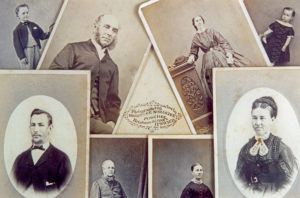Biggingee Sorabjee Poochee was born in Bombay, India where he opened his first photography business in a studio on Military Square Lane. It is thought that Poochee first made his way to Australia in the early 1860’s upon which he married Mary Ann Williams in Parramatta, New South Wales. He was said to have come to Australia, like many other immigrants of this time, to take advantage of the gold strikes. However, after the initial gold fever had diminshed he and his wife made their way to Queensland where they settled in the then thriving town of Ipswich.
In October of 1863 Poochee established his first photography business in Australia in a studio on the corner of Bell and Union Streets, Ipswich. After only two months Biggingee opened a second studio on January of 1864 in the Bullocks Building on Queen Street, Brisbane. While practising photography in both studios Poochee used the Carte de Visites process, which involved the mounting of photographs onto small postcard sized boards that were often given to family members and friends as mementos. As well as this process Poochee also made use of the sennotype process, which involved the enveloping of two identical albumen photographs together behind glass giving the print a 3D quality. While utilising this process at his Ipswich and Brisbane studios Biggingee suggested that women wear dresses of dark green or red and men wear suits and cravats of grey or black as these colours gave the best quality results within the final print. Poochee often explained in his newspaper adverts that this photography process also gave the subject a softer appearance and the print rarely faded like other processes used at this time.

A compilation of photographs taken by Biggingee Sorabjee Poochee using the carte de Visties process – Image courtesy of Picture Ipswich
B. S. Poochee operated out of his Brisbane and Ipswich studios for four years before travelling to Sydney in 1867. After which he then made his way back to Ipswich, where he opened a new studio and gallery on Brisbane Street which later became the premises for F. A. Whitehead Studios. While working in the Ipswich area Poochee introduced a number of new and improved portrait photography processes which became popular with residents. As a photographer in Ipswich he often photographed prominent families and buildings and was also commissioned to produce his most famous work entitled ‘Panorama of Ipswich’ in 1865. At the time this panorama displayed the growth and change occurring in the Ipswich area whilst showcasing some of Ipswich’s most famous landmarks including Gooloowan, Limestone Hill, and the School of Arts building.
Poochee won several awards for the panorama including one presented at the Great Centennial Exhibition in America in 1876 and another presented in 1866 in Melbourne at the Inter-Colonial Exhibition. The Ipswich panorama was later thought to be presented to the Mayor of the time in 1865. As well as his famous panoramic photograph Poochee showed much interest in the buildings of the Ipswich area, including that of the Congregational Church on Brisbane Street (erected in 1871). As a photographer during this time B. S. Poochee’s main role was in producing portraits in and around the area for residents who could afford such a service. Often these portraits featured prominent Ipswich businessmen, families and identities of the time.

Photographs such as this one are testament to Poochee’s commitment to serving those in and around the area of Ipswich – Image courtesy of Picture Ipswich
While practising and living in the Ipswich area Poochee was also reported to have taught famous Ipswich photographer Francis Whitehead the art of portrait photography who later established Whitehead Studios. Poochee’s studio neighboured the Whitehead family’s Brisbane Street address and Francis was often found in Poochee’s company as a young boy, observing the wonderful photographic process. As well as his photography enterprises Biggingee also had a great interest in the West Moreton area, particularly the Rosewood Scrub/Walloon district. During the 1870’s he became a pioneer sugar cane grower after planting and cultivating two varieties of cane on his 51 hectare property. Poochee was one of the first people to successfully grow cane in the West Moreton district after many attempts were made by local residents. After this success he decided to lease his studio in Ipswich and start a sugar crushing mill in 1871.
In 1877 having exhausted his time in Ipswich Poochee made tracks through regional and remote Queensland where he set up various studios in Dalby, Maryborough, Gayndah, and Townsville. He travelled throughout Queensland until 1882. While visiting these regional towns Poochee was also known to venture from his established studios and travel to more remote and smaller towns taking a small tent and his photography equipment with him. He would then set up his travelling studio and promote his services to residents in the area. After travelling throughout Queensland he made his way south to Parramatta in 1893, where he worked in conjunction with his son Sorabjee Poochee at his studio on Factory Street. He later opened his own studio, Poochee & Son, on Church Street and was said to operate here until 1904, when no more records could be found of his endeavours in Australia. Today Biggingee Sorabjee Poochee lives on through his outstanding representation of the thriving city of Ipswich and its residents. He was a master of his art and he shared this with many people in Queensland.
Information taken from: “A Queenslander in America” The Queenslander newspaper 29/07/1876, “Links with the long ago: Gleanings from The Queenslander” The Queenslander newspaper 24/04/1932, “To Let” advertisement The Brisbane Courier 20/09/1872, “The Exhibition: Official distribution of prizes” The Argus newspaper 14/02/1867, “Country news by mail” The Queenslander 21/01/1871, Queenslanders behind the Camera: Professional photographers in Queensland by Sandy Barrie, The Mechanical Eye: a historical guide to Australian photography and photographers by Alan Davies & Peter Stanbury with assistance form Con Tanre
